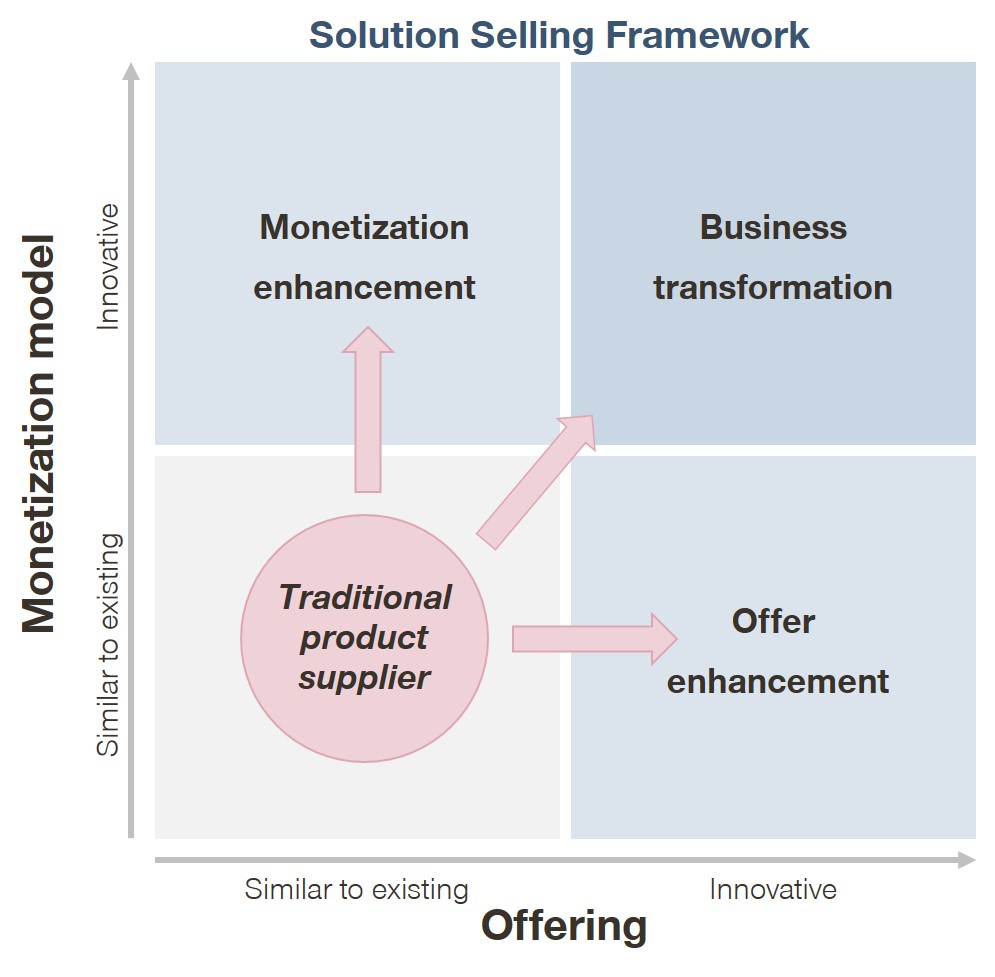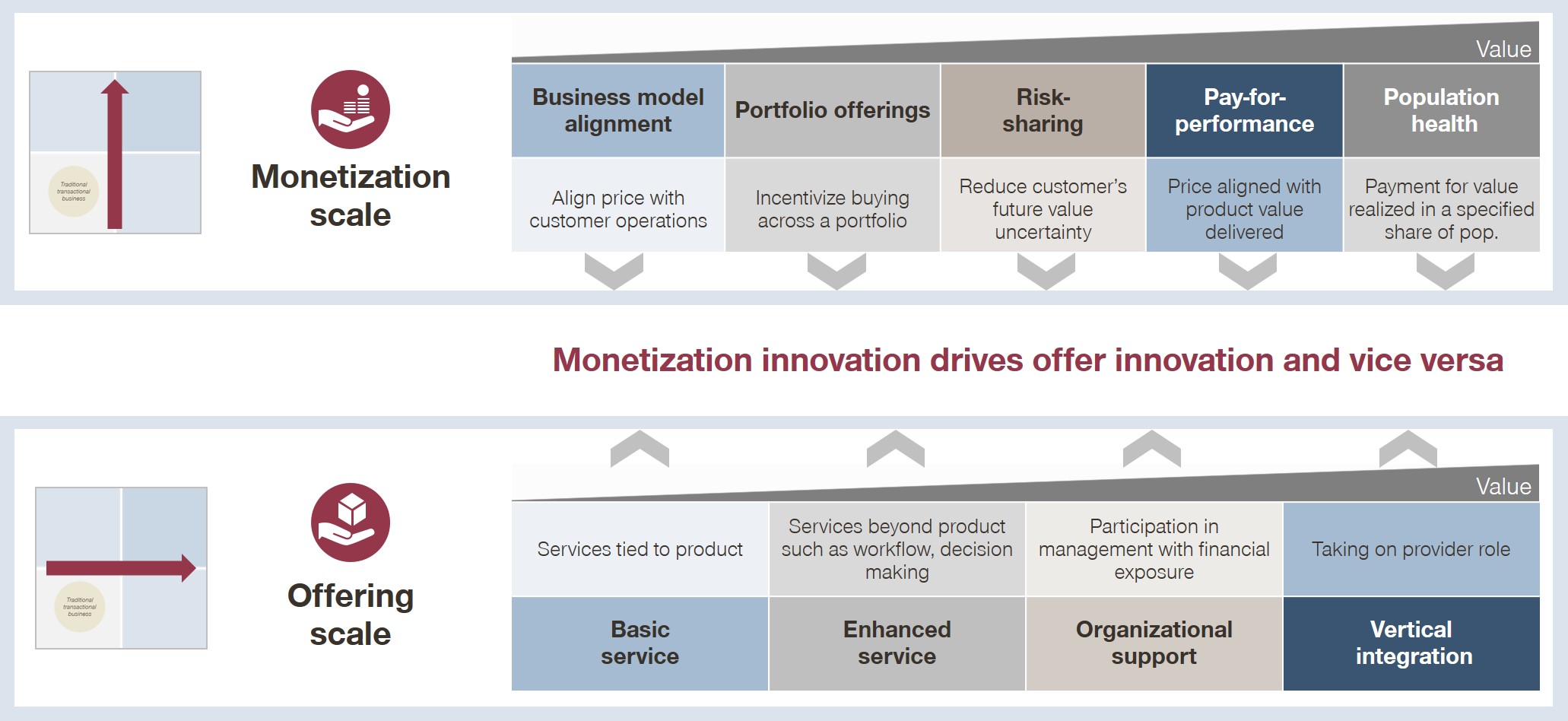During the last months, healthcare providers experienced an increasing pressure to cut costs. One way for them to do so is to lower their spending regarding MedTech suppliers. To counteract this price pressure, MedTech companies need to change their business model from being a product supplier to becoming a solution provider. What are the first steps in this transition?
Changing your business model is never easy. However, due to the ongoing price pressure in the healthcare market, many MedTech companies have little to no choice if they’re looking for long-term success. In the first two parts of our series, we have already outlined why the time to act is now and what strategic basis is needed by MedTech companies.
The next step for MedTech companies is to get their transformation into a solution provider started. How can they tell which direction to take their first steps? First of all, we have to differentiate between two very different reasons to pursue the transition to become a solution provider: It can be either a proactive transition or a reactive adjustment.
Becoming a solution provider: by proactive transition or reactive adjustment?
With MedTech companies about to start their journey towards becoming a solution provider, we experience often these two different reasons to pursue the change. Especially companies which do not experience cost pressure from healthcare providers very intensely at the moment lean towards changing their business model proactively to avoid price pressure in the future. Quite often, their goal is to reframe the discussion on the overall value offered before it’s too late. They want to demonstrate their ability to drive outcomes via products and capabilities and at the same time break the downward spiral of discounting in established product categories as well as overcome concerns about new products.
By far the greater number is, however, MedTech companies that already struggle with cost cutting from healthcare providers’ and need to become active to avoid revenue losses. By reacting to this development, they hope they will be able to meet the needs of outcome-focused customers better and also provide more value that deals with customer concerns more effectively. Their goal is to establish a better position regarding competitors that already entered solid partnerships with providers.
2 prerequisites: organizational capabilities and willingness to add risk
No matter whether MedTech firms are acting or reacting – with both approaches, the companies need key prerequisites for their transition into a solution provider to be successful. The first one is a certain appetite for risks. Managers need to have a high tolerance for financial variability as well as a certain acceptance of outcome risks due to product failure. MedTech companies also have to be able to sustain a variability in revenue flow, otherwise they won’t be able to achieve their goal in the long-term because they are likely to abort their mission prematurely.
A second requirement are suitable organizational capabilities. MedTech firms need to be able to organize or generate the required data to develop solutions. They have to build or buy the know-how to gather analytical insights into the role of products and solutions that are driving outcomes. In addition, managers need to set up sales teams and an infrastructure that have the ability and capabilities to execute solution selling.
Monetization and offering define the solution selling framework
Once MedTech companies ensured the right mind-set as well as the necessary capabilities, the next vital step is to start driving innovations in order to become a successful solution provider. Thereby they rely on being innovative across two dimensions: the offering and the monetization model tied to it.

How could innovations in these two areas look like? For companies’ monetization models it basically means to step away from traditional cost-plus pricing. More innovative options are for example models taking the financial ownership of population’s need for a certain type of care (e.g. diabetes care or cardiology). Other examples would be subscriptions, financial outcomes guarantees, pay for performance models, economic outcomes guarantees, and per procedure cost models.
Regarding the offer structure, to be more innovative MedTech companies could start to provide virtual or physical product packaging, and added services tied to physical products, workflow or business activities. Additionally, they could offer entrepreneurial exposure (e.g. operator model) and a full vertical integration of their offering.
Update of monetization model and offering structure are complementary
To achieve a full-on successful business transformation, it may be not sufficient to only innovate into one dimension. MedTech firms have to be innovative in their monetization model and their offering design to truly make their business model as a solution provider profitable. Luckily, we experience often that innovation along both axes happens in synch – new offerings allow for changes in monetization and vice versa.

This interplay of different factors, fed by innovative monetization models and an up-to-date offer structure, allow for more modern MedTech business models. And those unique business transformation models will drive the transition from a product supplier to an integral solution provider most effectively.
In the fourth part of our series you can learn more about which MedTech companies successfully completed the transformation from a product supplier to a solution provider. Read more!
_________________________________________________________________________________
Read more from this series:
Part 1: From Product Supplier to Solution Provider: Why MedTech Companies Need to Act Now!
Part 2. From Product Supplier to Solution Provider: How MedTech Firms Can Master This Transition
Part 4: From Product Supplier to Solution Provider: How 2 Medtech Firms Accomplished the Transformation








